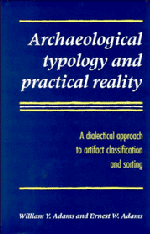 Archaeological Typology and Practical Reality
Archaeological Typology and Practical Reality Published online by Cambridge University Press: 23 November 2009
Critics have been heard to complain that for archaeologists typologies are a kind of fetish, and that classification may become an end in itself (Kluckhohn 1939: 338; Bennett 1943: 208; Hill and Evans 1972: 231, 267; Vierra 1982: 164; Hayden 1984: 81). This view seems to imply that some typologies serve no useful purpose. Usefulness, however, is very much in the eye of the beholder. As individuals we constantly encounter typologies that are of no use to us in our own work; for example, WYA has never found a bead typology that adequately describes the beads from his own excavations in Nubia. It is evident nevertheless that the many existing Nubian and Egyptian bead typologies (e.g. Reisner 1923b: 106–27; Steindorff 1935: 46–50; Emery 1938: pls. 43–4) served the practical needs of their makers, in that they permitted the description of a large and diverse body of material within a limited number of pages (cf. Everitt 1974:4).
If a typology appears to serve no obvious purpose, it probably means only that the typologist neglected to specify what his purpose was. This seems to be a fairly common failing (cf. Gardin 1980: 81). It may also be that the typology-maker was himself not consciously aware of his purpose, something that is perhaps also common (cf. Klejn 1982: 51–4). But we doubt that there are any typologies for which the maker had no purpose at all, either consciously or unconsciously.
To save this book to your Kindle, first ensure [email protected] is added to your Approved Personal Document E-mail List under your Personal Document Settings on the Manage Your Content and Devices page of your Amazon account. Then enter the ‘name’ part of your Kindle email address below. Find out more about saving to your Kindle.
Note you can select to save to either the @free.kindle.com or @kindle.com variations. ‘@free.kindle.com’ emails are free but can only be saved to your device when it is connected to wi-fi. ‘@kindle.com’ emails can be delivered even when you are not connected to wi-fi, but note that service fees apply.
Find out more about the Kindle Personal Document Service.
To save content items to your account, please confirm that you agree to abide by our usage policies. If this is the first time you use this feature, you will be asked to authorise Cambridge Core to connect with your account. Find out more about saving content to Dropbox.
To save content items to your account, please confirm that you agree to abide by our usage policies. If this is the first time you use this feature, you will be asked to authorise Cambridge Core to connect with your account. Find out more about saving content to Google Drive.